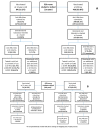Immunization against Hepatitis B Surface Antigen (HBsAg) in a Cohort of Nursing Students Two Decades after Vaccination: Surprising Feedback
- PMID: 31861551
- PMCID: PMC7157657
- DOI: 10.3390/vaccines8010001
Immunization against Hepatitis B Surface Antigen (HBsAg) in a Cohort of Nursing Students Two Decades after Vaccination: Surprising Feedback
Abstract
Health-care students can be exposed to biological risks during university training. The persistence of long-term immunogenicity against hepatitis B virus (HBV) was analyzed in a cohort of nursing students two decades after primary vaccination. A total of 520 students were enrolled at the University of Palermo and were evaluated for levels of anti-HBsAg antibodies. The students were examined during the first year of their Degree Course and were checked two years later. All students with anti-HBsAg <10 mIU/mL during their first or third year were boosted within one month. The proportion of students that were vaccinated during adolescence showing anti-HBsAg ≥10 mIU/mL was higher than that observed in students who were vaccinated during infancy (69% versus 31.7%; p-value <0.001). Receiving HBV vaccination at adolescence was significantly associated with a fourfold increased possibility of having anti-HBsAg titers ≥10 mIU/mL (adj-OR = 4.21, 95% CI: 2.43-7.30). Among the students who were checked at the third year and boosted after the first year (n = 279), those who were vaccinated during infancy showed a higher percentage of antibody titers <10 mIU/mL (20.3% versus 8.7% among vaccinated during adolescence; p <0.01). This study confirms that HBV vaccination at adolescence might determine a higher long-term persistence of anti-HBsAg titers ≥10 mIU/mL and that anti-HBV booster could increase levels of anti-HBsAg over a relatively short period, especially in subjects who were vaccinated during infancy.
Keywords: Anti-HBs titer; HBV infection; HBV vaccination; Healthcare students; work related biological risk.
Conflict of interest statement
The authors declare no conflict of interest.
Figures
Similar articles
-
Persistence of protective anti-HBs antibody levels and anamnestic response to HBV booster vaccination: A cross-sectional study among healthcare students 20 years following the universal immunization campaign in Italy.Hum Vaccin Immunother. 2017 Feb;13(2):440-444. doi: 10.1080/21645515.2017.1264788. Hum Vaccin Immunother. 2017. PMID: 27925503 Free PMC article.
-
Significance and anamnestic response in isolated hepatitis B core antibody-positive individuals 18 years after neonatal hepatitis B virus vaccination in Taiwan.Vaccine. 2012 Jun 8;30(27):4034-9. doi: 10.1016/j.vaccine.2012.04.031. Epub 2012 Apr 22. Vaccine. 2012. PMID: 22531558
-
Long-term persistency of hepatitis B immunity: an observational cross-sectional study on medical students and resident doctors.J Prev Med Hyg. 2019 Sep 30;60(3):E184-E190. doi: 10.15167/2421-4248/jpmh2019.60.3.1315. eCollection 2019 Sep. J Prev Med Hyg. 2019. PMID: 31650052 Free PMC article.
-
Vaccine- and hepatitis B immune globulin-induced escape mutations of hepatitis B virus surface antigen.J Biomed Sci. 2001 May-Jun;8(3):237-47. doi: 10.1007/BF02256597. J Biomed Sci. 2001. PMID: 11385295 Review.
-
The Effectiveness and Sero-Immunity of Hepatitis B Vaccination in People Who Use Drugs: A Systematic Review and Meta-Analysis.Vaccines (Basel). 2024 Sep 8;12(9):1026. doi: 10.3390/vaccines12091026. Vaccines (Basel). 2024. PMID: 39340056 Free PMC article. Review.
Cited by
-
Long-Term Effectiveness of Hepatitis B Vaccination in the Protection of Healthcare Students in Highly Developed Countries: A Systematic Review and Meta-Analysis.Vaccines (Basel). 2022 Oct 30;10(11):1841. doi: 10.3390/vaccines10111841. Vaccines (Basel). 2022. PMID: 36366350 Free PMC article. Review.
-
Hepatitis B Seroprevalence in the Pediatric and Adolescent Population of Florence (Italy): An Update 27 Years after the Implementation of Universal Vaccination.Vaccines (Basel). 2020 Mar 30;8(2):156. doi: 10.3390/vaccines8020156. Vaccines (Basel). 2020. PMID: 32235670 Free PMC article.
-
A Systematic Review of the Current Hepatitis B Viral Infection and Hepatocellular Carcinoma Situation in Mediterranean Countries.Biomed Res Int. 2020 Jun 10;2020:7027169. doi: 10.1155/2020/7027169. eCollection 2020. Biomed Res Int. 2020. PMID: 32626758 Free PMC article.
-
Hepatitis B antibody levels after different doses of hepatitis B vaccination: a retrospective study based on hospitalized children.Epidemiol Infect. 2023 Oct 26;151:e186. doi: 10.1017/S0950268823001747. Epidemiol Infect. 2023. PMID: 37881897 Free PMC article.
-
Seroprevalence of hepatitis B, C, and D and associated factors in the semi-isolated Yanomami Amazonian indigenous community.BMC Infect Dis. 2024 Jan 2;24(1):15. doi: 10.1186/s12879-023-08928-z. BMC Infect Dis. 2024. PMID: 38166687 Free PMC article.
References
-
- World Health Organization (WHO) Occupational Health, Health Workers and Health Worker Occupational Health. [(accessed on 6 November 2019)]; Available online: http://www.who.int/occupa-tional_health/topics/hcworkers/en/
-
- Repubblica Italiana-Decreto Legislativo 9 Aprile 2008, n. 81. Attuazione Dell’articolo 1 Della Legge 3 Agosto 2007, n. 123 in Materia Di Tutela Della Salute e Della Sicurezza Nei Luoghi Di Lavoro. [(accessed on 6 November 2019)]; Available online: https://www.gazzettaufficiale.it/eli/id/2008/04/30/008G0104/sg.
-
- Advisory Committee on Immunization Practices. Centers for Disease Control and Prevention (CDC) Immunization of Healthcare Personnel: Recommendations of the Advisory Committee on Immunization Practices (ACIP) Mmwr Recomm. Rep. 2011;60:1–45. - PubMed
LinkOut - more resources
Full Text Sources


